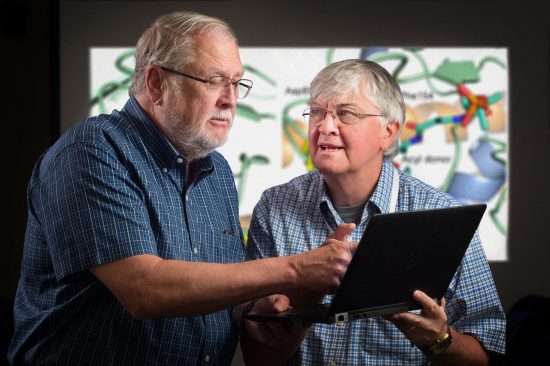Boat-shaped membrane protein offers novel solution for working in the cell membrane

St. Jude Children's Research Hospital scientists have identified a novel structure that helps an enzyme solve a challenging biological problem by bobbing like a ship at the surface of the cell membrane. The finding offers a glimpse of how life works at the molecular level and a possible new target for antibiotics in the future.
The research appeared this week as an advance online publication in Nature Structural and Molecular Biology. The study focused on a family of membrane proteins that are found in the simplest to the most complex forms of life.
Researchers knew that the protein, called lysophosphatidic acid acyltransferase or PlsC in bacteria, was essential for assembling the phospholipid molecules that are the main component of cell membranes. Scientists also knew the enzyme's role in the production process was to attach a molecule from the water-loving (hydrophilic) cytosol to an incomplete phospholipid in the oil-loving (hydrophobic) interior of the membrane. In this study, researchers identified how PlsC accomplished that feat.
"We all know that oil and water don't mix. Scientists have been stumped by how this family of enzymes bridged that divide," said Charles Rock, Ph.D., a member of the St. Jude Department of Infectious Diseases. He and Stephen White, D.Phil., a member of the St. Jude Department of Structural Biology, led the research and are co-corresponding authors of the study. White said: "Other researchers had tried to model the process based on existing transmembrane protein structures, and the models didn't make sense for this task."
To understand the enzyme's success, White and his colleagues in Structural Biology crystallized a heat-stable PlsC from a bacterium that lives at high temperature. The protein structure—backed up with evidence from laboratory experiments and molecular dynamics simulations—led investigators to the solution.
"Turns out, nature designed a very clever 'boat' that solved the topological problem for this, and likely thousands of other similar proteins," Rock said. "The protein looked like nothing we had seen before; yet every organism, including humans, has these proteins."
Transmembrane proteins typically pass through and extend on either side of the membrane. By studying the amino acids that make up PlsC and evaluating other clues, St. Jude researchers determined that PlsC could not adopt this structure. Instead, the PlsC crystal structure revealed a boat-shaped molecule that sails on the surface of the phospholipid bilayer rather than extending through the membrane.
Like the stabilizing keel of a ship, researchers reported that PlsC had a hydrophobic segment that extended into the cell membrane interior. That anchored the enzyme in the membrane, giving PlsC direct access to its partially completed phospholipid substrate and producing a mature phospholipid for cell membrane growth. PlsC also had a hydrophilic segment that extended into the cytosol to access the water-soluble substrate.
By mutating PlsC, researchers confirmed how the protein was anchored in the cell membrane, and the correct acyl group was selected from the cytosol.
"Different bacteria use different acyl chains to control membrane dynamics," White said. "At the atomic level, the protein structure creates two tunnels that serve as pathways for the two substrates to meet at the PlsC active site where the chemistry magic happens. One substrate enters the first tunnel from the membrane, and the soluble acyl group enters from the other end and docks into the second tunnel."
By mutating the bacterial PlsC to vary the length of the second tunnel, researchers showed that its length exquisitely determined which acyl group was selected for the reaction. "The tunnel functioned like a ruler to select the correct acyl group that fits in the tunnel to create the desired membrane properties," Rock said.
Molecular dynamics simulations run on the St. Jude supercomputer confirmed the researchers' hypothesis about how PlsC functioned and fulfilled its role. "The structure provides an architectural solution that has never been seen before and that is used with slight variations by similar proteins to catalyze diverse biochemical reactions within the cell membrane," Rock said.
More information: Rosanna M Robertson et al. A two-helix motif positions the lysophosphatidic acid acyltransferase active site for catalysis within the membrane bilayer, Nature Structural & Molecular Biology (2017). DOI: 10.1038/nsmb.3436
Journal information: Nature Structural & Molecular Biology , Nature Structural and Molecular Biology
Provided by St. Jude Children's Research Hospital


















